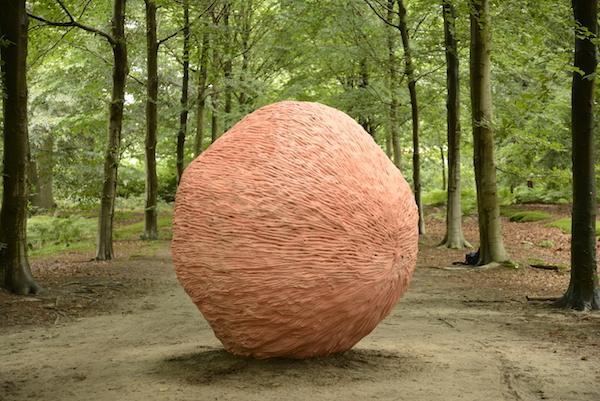Lustwarande 2015, RApture & Pain, August 29 - October 25, 2015, De Oude Warande forest, Tilburg, NEtherlands
Blind Spot, 2, 2015, Lustwarande, Rupture & Pain, 2015, installation view, commission of new monumental sculpture, De Oude Warande forest, Tilburg, Netherlands
Lustwarande 2015, Rupture & Pain, August 29 - October 25, 2015, commission of new monumental sculpture, De Oude Warande forest, Tilburg, Netherlands
Lustwarande
De Oude Warande was built in 1712 by the German prince Wilhelm von Hessen-Kassel, at that time lord of the Manor of Tilburg and Goirle. He created the forest according to the latest fashion garden, the Baroque. Warande is derived from the French varenne, meaning hunting enclosure or pleasure garden. The main design is a sterrebos (a star-shaped wood), while the paths of the four quadrants have been constructed in various geometric shapes, so that the system of paths constitutes a maze. Such parks were usually enlivened with sculptures, caves and ponds. In De Oude Warande no remnants of sculptures have been found. During the 19th century the park switched owners several times. In 1952 the municipality of Tilburg became the owner. Since 2000 Fundament Foundation completes this best-preserved Baroque woodlands of Netherlands every three to four years with a temporary international group exhibition, Lustwarande.
Lustwarande ’15 – Rapture & Pain
Like previous editions, Lustwarande ’15 – Rapture & Pain displayed a range of works illustrating developments in international contemporary sculpture. While the first decade of the 21st century saw the medium of sculpture regain its status and appreciation, it should at the same time be acknowledged that no significant new developments have taken place within the genre since the early years of the current decade; all conceivable forms of sculpture have been widely explored and constantly applied within the continuing (re-)examination of Modernism (reloading Modernism/Altermodernism, Nicolas Bourriaud, 2005).
So Lustwarande ’15 did not so much claim to show new tendencies, but investigated primarily the relationship between contemporary sculpture and the zeitgeist. Social criticism and commentary through aesthetics in art are nothing new, but a renewed focus on these aspects may have a revitalising effect within our changing social frameworks. A current analysis of its roots in society may recapture territory for art and, ultimately, also result in social gain. This criticism of society is not unambiguous, but operates on a sliding scale, with pessimism and optimism at its extremes.
Rapture & Pain dealt with contemporary notions of progress, in which expressions of hope, ecstasy and utopia were alternated with manifestations of doubt, fear and degeneration. The values involved are rarely opposites. The various expressions of social criticism are more likely located around the broad middle spectrum, where they both diverge and converge, just as ecstasy and pain are often extensions of each other.
Blind Spot II (2015), the new version of an earlier work that Leite developed for Lustwarande ’15, marks a further exploration of space. The sculpture was created by coating the interior of a large free-standing plywood mould, which Leite entered from below, with wet clay, within which the artist performed horizontal movements. The negative form was subsequently treated with plaster and acrylic polymer. The asymmetry of the human body forced Leite to restrict her arm movements. As Leite could not reach fully around her back, the rear of the work is less detailed than the front, and the sculpture does not form a perfect circle. The imperfection is the result of the position and orientation of the human body. By exploring the space with hands and feet, Leite investigates the reach and limitations of her body. In this respect, Blind Spot shows striking similarities with a number of earlier works by the British artist Antony Gormley (b. 1950), such as Earth, Fruit and Body (1991/93). Blind Spot II is, however, more than an intimate imprint of Leite’s body; it shows both the physical potential and the limitations of the female body in appropriating space for itself.
Participating artists
Atelier van Lieshout (NL) – Kevin van Braak (NL) – Tim Breukers (NL) – Tom Burr (USA) – Feipel & Bechameil (LUX/F) – Roger Hiorns (GB) – Folkert de Jong (NL) – Juliana Cerqueira Leite (USA) – Gabriel Lester (NL) – Wilhelm Mundt (D) – Arne Quinze (B) – Ugo Rondinone (CH) – Maria Roosen (NL, at PARK – Platform for Visual Arts) -Daniel Roth (D) – Eva Rothschild (IRL) – William Tucker (GB) – Jan Van Oost (B)

